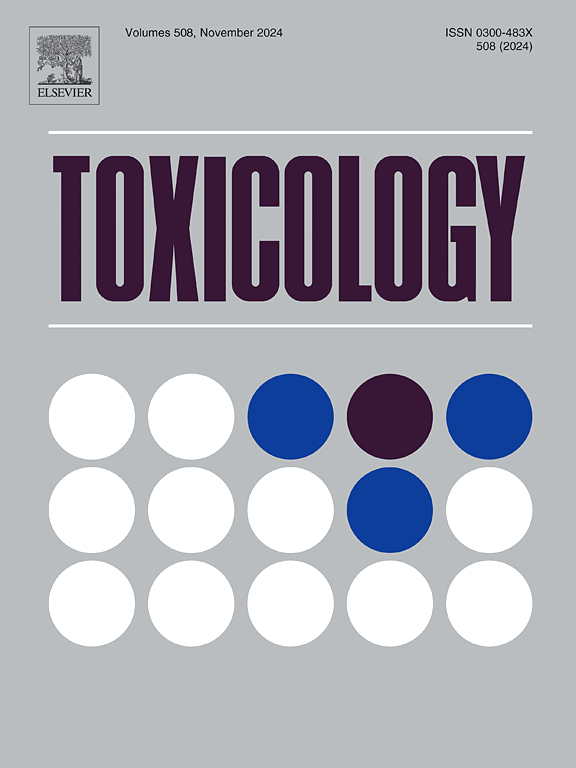全氟和多氟烷基物质作为暴露框架下肝毒性的增强剂:当前环境毒理学的挑战
IF 4.6
3区 医学
Q1 PHARMACOLOGY & PHARMACY
引用次数: 0
摘要
慢性肝病,包括代谢功能障碍相关的脂肪性肝病(MASLD)和肝细胞癌(HCC),正在上升,可能是由于每天暴露于构成暴露体一部分的复杂化合物混合物。了解这些混合物的肝毒性机制对于确定可能在分子水平上突出潜在相互作用的共同分子靶点至关重要。我们用两类环境污染物,全氟和多氟烷基物质(PFAS)和杂环芳香胺(HAAs)说明了这一问题,这两类污染物都可能参与慢性肝病的进展,并且它们的毒性可能通过外源代谢水平的相互作用而增强。在慢性肝病暴露效应的研究中,包括组学分析和来自各种体外、体内和计算机方法的数据在内的新方法方法(NAMs)对于提高人类毒理学研究的预测性,同时减少动物实验至关重要。此外,开发复杂的体外人类肝细胞模型,如类器官,对于避免物种间差异至关重要,从而将人类的风险降到最低。总之,这些方法将有助于构建不良结果通路(AOPs),不仅可以应用于PFAS混合物,还可以应用于其他化学家族,为暴露体研究中的混合物肝毒性预测提供有价值的见解。更好地了解毒理学机制将澄清环境污染物混合物在MASLD和HCC发展中的作用,支持风险评估,以便更好地治疗、监测和预防策略。本文章由计算机程序翻译,如有差异,请以英文原文为准。
Per- and polyfluoroalkyl substances as potentiators of hepatotoxicity in an exposome framework: Current challenges of environmental toxicology
Chronic liver diseases, including metabolic dysfunction-associated steatosic liver disease (MASLD) and hepatocellular carcinoma (HCC), are on the rise, potentially due to daily exposure to complex mixtures of chemical compounds forming part of the exposome. Understanding the mechanisms involved in hepatotoxicity of these mixtures is essential to identify common molecular targets that may highlight potential interactions at the molecular level. We illustrated this issue with two families of environmental contaminants, per- and polyfluoroalkyl substances (PFAS) and heterocyclic aromatic amines (HAAs), both of which could be involved in the progression of chronic liver diseases, and whose toxicity may be potentiated by interactions at the level of xenobiotic metabolism. In the study of exposome effects on chronic liver disease, New Approach Methodologies (NAMs) including omics analyses and data from various in vitro, in vivo and in silico approaches, are crucial for improving predictivity of toxicological studies in humans while reducing animal experimentation. Additionally, the development of complex in vitro human liver cell models, such as organoids, is essential to avoid interspecies differences that minimize the risk for humans. All together, these approaches will contribute to construct Adverse Outcome Pathways (AOPs) and could be applied not only to PFAS mixtures but also to other chemical families, providing valuable insights into mixture hepatotoxicity prediction in the study of the exposome. A better understanding of toxicological mechanisms will clarify the role of environmental contaminant mixtures in the development of MASLD and HCC, supporting risk assessment for better treatment, monitoring and prevention strategies.
求助全文
通过发布文献求助,成功后即可免费获取论文全文。
去求助
来源期刊

Toxicology
医学-毒理学
CiteScore
7.80
自引率
4.40%
发文量
222
审稿时长
23 days
期刊介绍:
Toxicology is an international, peer-reviewed journal that publishes only the highest quality original scientific research and critical reviews describing hypothesis-based investigations into mechanisms of toxicity associated with exposures to xenobiotic chemicals, particularly as it relates to human health. In this respect "mechanisms" is defined on both the macro (e.g. physiological, biological, kinetic, species, sex, etc.) and molecular (genomic, transcriptomic, metabolic, etc.) scale. Emphasis is placed on findings that identify novel hazards and that can be extrapolated to exposures and mechanisms that are relevant to estimating human risk. Toxicology also publishes brief communications, personal commentaries and opinion articles, as well as concise expert reviews on contemporary topics. All research and review articles published in Toxicology are subject to rigorous peer review. Authors are asked to contact the Editor-in-Chief prior to submitting review articles or commentaries for consideration for publication in Toxicology.
 求助内容:
求助内容: 应助结果提醒方式:
应助结果提醒方式:


